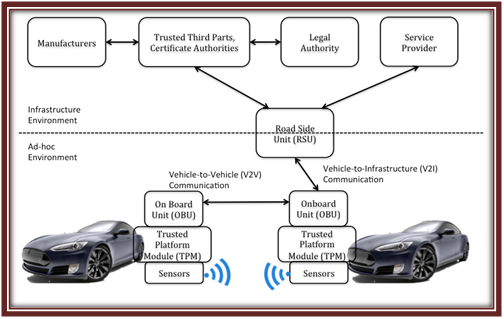NS3 Vanet Simulation (Vehicle Ad-hoc Networks) is emergent technologies that they deserve, recently, the attention of the industry and the academics institutions.We assist Engineering students and Research Scholars in creating Ns3 Vanet simulation Projects.For example, acknowledgments of the ambient conditions (snow, fire, etc.), traffic in the road conditions (emergency, construction sites, or congestion).
Security system requirements of VANET:
- Damper proof device.
- VPKI (Vehicular PKI).
- Digital signature (DS).
Components of flexible connectivity management in VANET:
- CALM.
- MoH (Modules of Handoff).
- V2V.
- I2I.
- IPV6.
- SAP (Service Access Point).
- IP & NON IP Services.
- Medium selection & switching.
- V2I.
Broadcasting mechanisms in VANET:
- Cluster-based broadcast.
- Flooding.
- Probabilistic broadcast.
- Location-based broadcast.
- Counter-based broadcast.
Architecture of VANET:
Sample code for VANET:
simple VANET device receive vsa and send WSAExample
bool WaveNetDeviceExample::ReceiveVsa (Ptr<const Packet> pkt,const Address & address, uint32_t, uint32_t) { std::cout << "receive a VSA management frame: recvTime = " << Now ().GetSeconds () << "s." << std::endl; return true; } void WaveNetDeviceExample::SendWsaExample () { CreateWaveNodes (); Ptr<WaveNetDevice> sender = DynamicCast<WaveNetDevice> (devices.Get (0)); Ptr<WaveNetDevice> receiver = DynamicCast<WaveNetDevice> (devices.Get (1)); const SchInfo schInfo = SchInfo (SCH1, false, EXTENDED_ALTERNATING); Simulator::Schedule (Seconds (0.0), &WaveNetDevice::StartSch, sender, schInfo); Simulator::Schedule (Seconds (0.0), &WaveNetDevice::StartSch, receiver, schInfo); Ptr<Packet> wsaPacket = Create<Packet> (100); Mac48Address dest = Mac48Address::GetBroadcast (); const VsaInfo vsaInfo = VsaInfo (dest, OrganizationIdentifier (), 0, wsaPacket, SCH1, 100, VSA_TRANSMIT_IN_BOTHI); Simulator::Schedule (Seconds (1.0), &WaveNetDevice::StartVsa, sender, vsaInfo); Simulator::Schedule (Seconds (3.0), &WaveNetDevice::StopVsa, sender, SCH1); Simulator::Schedule (Seconds (4.0), &WaveNetDevice::StopSch, sender, SCH1); Simulator::Schedule (Seconds (4.0), &WaveNetDevice::StopSch, receiver, SCH1); Simulator::Schedule (Seconds (5.0), &WaveNetDevice::StartVsa, sender, vsaInfo); Simulator::Schedule (Seconds (6.0), &WaveNetDevice::StopVsa, sender, SCH1); Simulator::Stop (Seconds (6.0)); Simulator::Run (); Simulator::Destroy (); }

